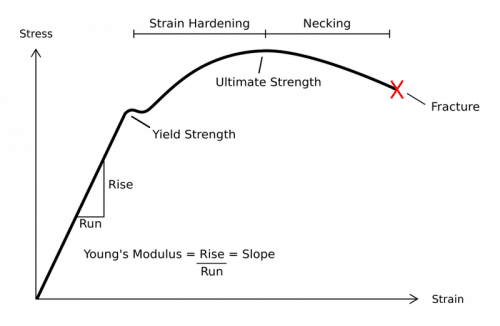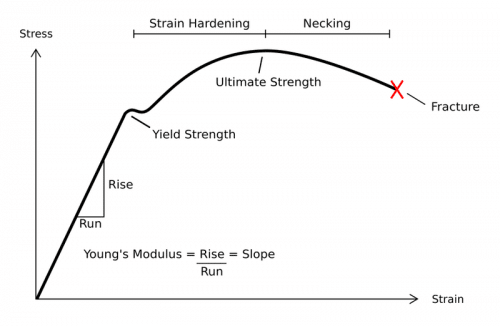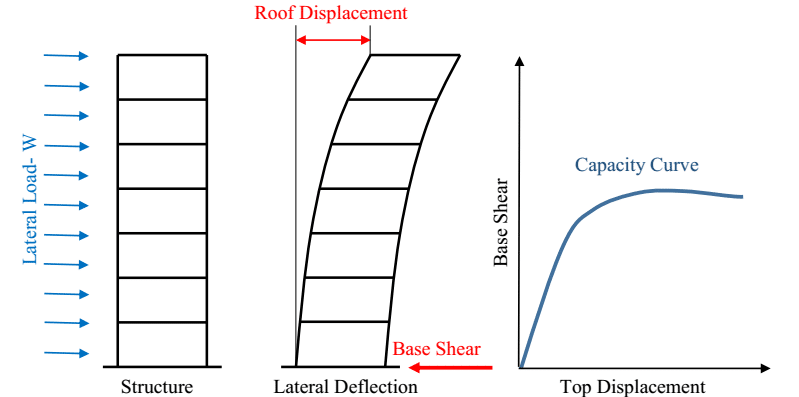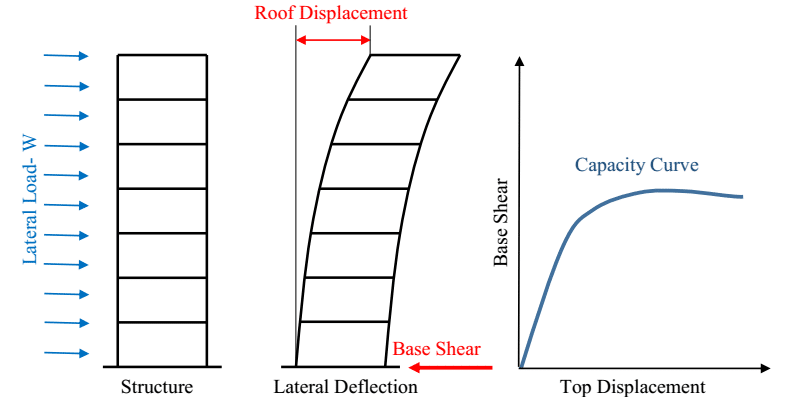Pushover analysis is a powerful technique used in civil engineering to evaluate the performance of buildings and infrastructure under seismic loading. This method provides valuable information about the behavior of structures beyond the elastic limit, giving engineers a comprehensive understanding of their response to extreme events. In this article, we will delve into the ins and outs of pushover analysis, explore its applications, and discuss the steps for conducting this analysis.
In the field of civil engineering, analyzing the behavior of buildings and infrastructures under seismic effects is extremely important. Traditional analytical methods often assume linear behavior and do not capture the complex interactions that occur when a structure exceeds its elastic range. Pushover analysis, also known as nonlinear static analysis, provides a solution by simulating the inelastic behavior of structures.
Understanding Structural Behavior
Structural behavior can be broadly divided into two main types: elastic and inelastic behavior.
- Elastic behavior
When a structure is subjected to small loads, it responds in a linear and elastic way. This means that the deformations are directly proportional to the forces exerted and the structure returns to its original shape when the load is unloaded.
- Inelastic behavior
As the applied loads increase, the structure begins to exhibit inelastic behavior. In this area, the deformations are no longer proportional to the forces and the structure suffers permanent deformations. Pushover analysis focuses on capturing this inelastic behavior and evaluating the structure's performance under extreme loading conditions.


Purpose and Benefits of Pushover Analysis
It serves multiple purposes in civil engineering and offers numerous advantages in the design and evaluation of structures.
Structural performance assessment
One of the main objectives of pushover analysis is to evaluate the overall performance of a structure. By subjecting the structure to increasing stresses, engineers can identify weak points and potential failure mechanisms. This information helps optimize the design and improve structural robustness.
Seismic Performance Assessment
Earthquakes pose a significant risk to structures. Therefore, it is important to evaluate their performance under seismic load. Pushover analysis allows engineers to determine the structure's response to earthquakes and evaluate the adequacy of design measures. By taking into account the non-linear behavior and capacity of the structure, it becomes possible to estimate potential damage and make informed decisions regarding modernization or reinforcement measures.
Steps to follow in pushover analysis
To perform an analysis, several steps must be followed to ensure accurate results and meaningful interpretations.
- Modeling the structure
The first step is to create a detailed model of the structure using structural analysis software. The goal is to accurately represent the geometry, material properties and boundary conditions of the building or infrastructure. The model must capture the essential elements and their interactions to provide a realistic representation of the structure's behavior.
- Applying load patterns
Pushover analysis applies a series of load patterns to the structure in stages. These load patterns simulate the distribution of forces that can act on a structure during an earthquake. The magnitude and direction of the loads are gradually increased until the structure reaches its capacity or a predefined limit state.
- Nonlinear analysis
The core of pushover analysis is to perform nonlinear analysis. The nonlinear behavior of materials such as concrete and steel under increasing load is taken into account. Nonlinear analysis methods such as the fiber-based approach or the plastic hinge model are used to accurately capture the inelastic response of the structure.
- Performance evaluation
During the analysis, several performance parameters are monitored to evaluate the structure's behavior. These parameters include History Units Base Shear Forces and Plastic Hinge Rotations. By analyzing these results, engineers can assess structural integrity, identify potential failure modes, and quantify safety margins.


Pushover Analysis Techniques
Different analysis techniques are often used in practice, each with its own advantages and limitations.
- Force-based pushover analysis
In force-based analysis, applied loads are gradually increased until a predefined displacement or force capacity is reached. This technique focuses on the distribution of forces within the structure and provides information about the strength requirements of individual components or elements.
- Displacement-based pushover analysis
In contrast, displacement-based analysis applies incremental displacements to the structure. Loads are adjusted to maintain target displacements. This allows a more direct assessment of the deformation capacity and performance of the structure at different displacement levels.
- Capacity spectrum method
The capacity spectrum method combines aspects of force-based and displacement-based pushover analyses. It uses a predefined capacity spectrum that represents the relationship between demand and the structure's capacity. By comparing the demand spectrum obtained from ground motion analysis with the capacity spectrum, engineers can assess the suitability of the structure's design and identify potential deficiencies.
Limitations and Challenges of Pushover Analysis
While analysis provides valuable information, it is important to be aware of its limitations and challenges.
Assumptions and simplifications
Pushover analysis relies on several simplifying assumptions to speed up calculations and make the analysis computationally feasible. However, these simplifications may not represent the actual behavior of the structure, leading to potential discrepancies between analysis results and actual performance.
Nonlinearity Modeling
Accurate modeling of nonlinear behavior is crucial to obtaining reliable analysis results. However, it can be challenging to accurately capture complex nonlinearities in structural elements. Selecting appropriate material models and calibrating their parameters requires experience and careful consideration.
Precise selection of ground movement
The accuracy of pushover analysis largely depends on the selection of ground motion records. Selected recordings must be representative of the seismic hazard at the location and the frequency content and intensity of the potential earthquake . To obtain accurate analysis results, care must be taken to ensure that ground motion inputs are realistic and appropriate.
Case studies and applications
The analysis has been extensively applied in various real-world scenarios to evaluate the seismic performance of different types of structures.
- Imposing buildings
Tall buildings are subject to significant lateral loads during earthquakes. Pushover analysis allows engineers to evaluate the response of these structures, identify potential vulnerabilities, and optimize the design to ensure occupant safety. Helps determine if additional side reinforcements, damping devices, or structural improvements are needed to improve earthquake resistance.
- Bridges and infrastructure
Bridges and other critical infrastructure are vulnerable to seismic forces. Pushover analysis allows engineers to assess the vulnerability of these structures and assess their resistance to earthquakes. By considering the nonlinear behavior of bridge components such as piers and abutments, engineers can identify potential failure mechanisms and take appropriate retrofit measures.
- Historic buildings
Historic structures often lack detailed construction information and may not meet current seismic standards. Pushover analysis is a valuable tool for assessing the seismic risk of these structures and for supporting maintenance and modernization measures. By understanding their inelastic behavior, engineers can develop strategies to protect these cultural monuments from seismic hazards while preserving their architectural integrity.
Software tools for pushover analysis
To facilitate the implementation of pushover analysis, several software tools are available on the market that provide advanced modeling and analysis capabilities.
ETABS
ETABS (Extended Three-Dimensional Analysis of Building Systems) is a popular software often used for this. It provides a user-friendly interface for modeling complex structures, applying loads, and performing nonlinear static analysis. ETABS offers several options for pushover analysis, including force- and displacement-based methods, making it a versatile tool for engineers.
SAP2000
SAP2000 is another widely used software package. It offers a comprehensive set of tools for structural analysis and design. SAP2000 provides advanced nonlinear analysis capabilities, including pushover analysis, that enable engineers to efficiently evaluate the performance of structures under seismic loads.
Run 3D
Perform-3D is a specialized software tool specifically designed for nonlinear analysis including pushover analysis. Offers a range of advanced modeling options, material models and analysis algorithms to accurately simulate the behavior of structures under extreme loading conditions. Perform-3D is known for its robust analysis capabilities and ability to handle complex nonlinearities.
Pushover analysis is a powerful technique that allows engineers to evaluate the behavior and performance of structures beyond the elastic limit. By considering the inelastic response of buildings and infrastructure under seismic loads, this type of analysis provides valuable information to optimize design, retrofit strategies and evaluate seismic performance. Despite its limitations, pushover analysis, when performed with careful consideration and accurate modeling, contributes significantly to the advancement of civil engineering practice.
Common questions
What is the main objective of pushover analysis?
The main objective of this type of analysis is to evaluate the inelastic behavior and seismic resistance of structures. It helps engineers understand how a structure responds to increased loads and identify potential failure mechanisms and vulnerabilities.
What is the difference to conventional analysis methods?
Traditional analysis methods generally assume linear behavior and do not capture the inelastic response of structures. Pushover analysis, on the other hand, takes into account the nonlinear behavior and deformability of the structure, allowing a more realistic assessment of its seismic resistance.
Is pushover modeling applicable to all types of structures?
It can be applied to various types of structures, including buildings, bridges and infrastructure. However, its applicability may depend on the complexity and behavior of the structure. Model assumptions and selection of appropriate analysis techniques must be carefully considered.
Can pushover analysis be used to modernize existing structures?
Yes, it is commonly used to modernize existing structures. By performing a simple analysis on an existing building, engineers can assess its ability to withstand seismic loads and identify potential defects. This information helps plan modernization measures to improve structural performance and ensure occupant safety.
What should you pay special attention to when selecting analytics software?
When choosing simple analysis software, several important aspects must be considered. This includes the software's nonlinear analysis capabilities, its ease of use and interface, the availability of advanced modeling options, and compatibility with other analysis and design tools. Additionally, support and resources provided by the software vendor should be considered to ensure efficient implementation and troubleshooting.

